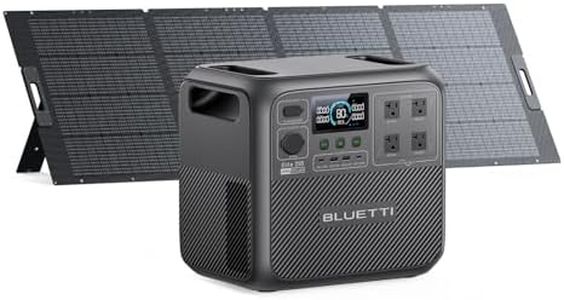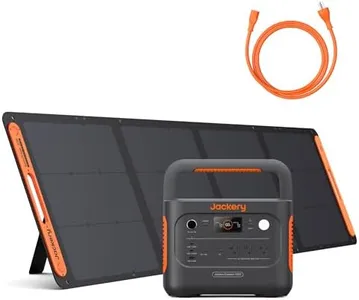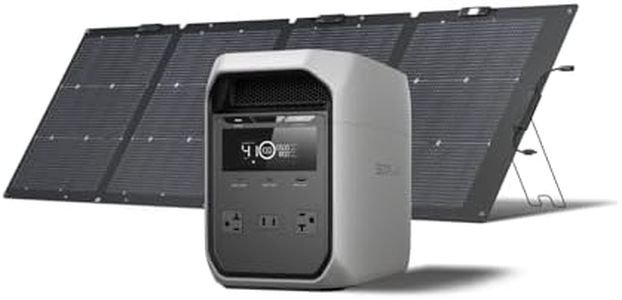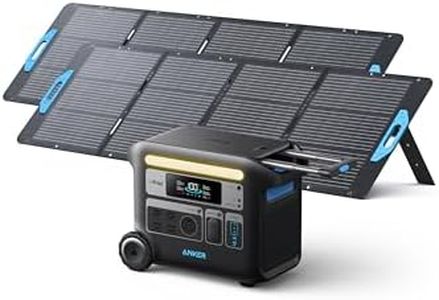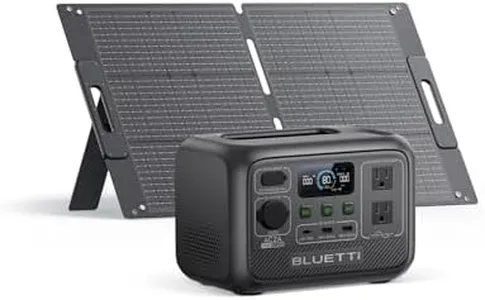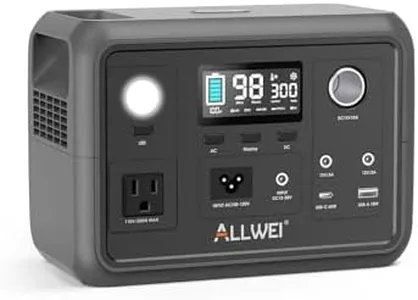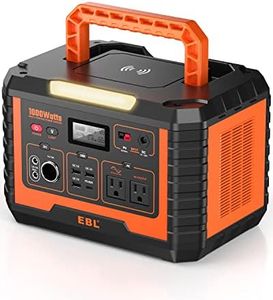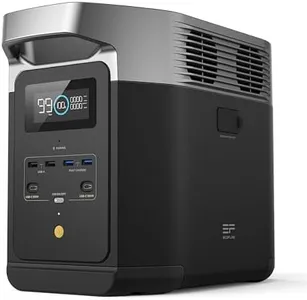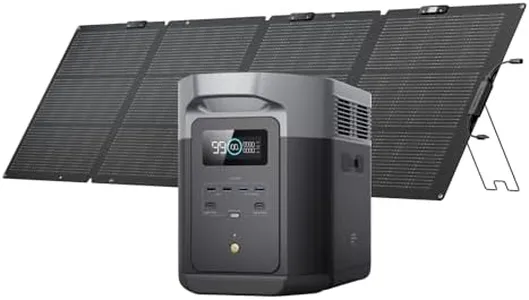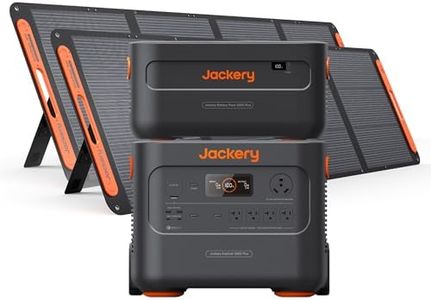10 Best Off Grid Solar Generators 2025 in the United States
Our technology thoroughly searches through the online shopping world, reviewing hundreds of sites. We then process and analyze this information, updating in real-time to bring you the latest top-rated products. This way, you always get the best and most current options available.

Our Top Picks
Winner
Jackery Solar Generator 1000 v2 with 200W Solar Panel,1070Wh Portable Power Station LiFePO4 Battery,1500W AC/100W USB-C Output,for Outdoor,Off-Grid Living,RV,Emergency (AC Cable Included)
Most important from
4146 reviews
The Jackery Solar Generator 1000 v2 is a solid choice if you need reliable, portable power for outdoor activities, emergency use, or off-grid living. With a 1,070Wh LiFePO4 battery, it can power essential appliances like fridges and small AC units with a steady 1,500W output and a surge up to 3,000W. Its pure sine wave inverter ensures clean and stable electricity, which is safe for sensitive devices. The unit is fairly portable, weighing just under 24 pounds and featuring a foldable handle, making it manageable for camping or RV trips.
Charging options are smart and flexible—with a 200W solar panel included, you can recharge using sunlight, and the generator also supports fast charging from an AC source, reaching full charge in about 1.7 hours under normal conditions or as fast as 1 hour in emergency mode via the app. The battery’s lifespan is impressive too, maintaining most of its capacity after thousands of cycles, so it should serve well for many years. It offers plenty of ports, including three AC outlets and multiple USB options, supporting simultaneous charging of various devices without extra adapters. The Jackery app adds convenience by letting you customize charging modes and monitor power use.
On the downside, while the solar input is decent, recharging solely by solar might take longer if sunlight is weak, and the 1,070Wh capacity is good but might not be enough for extended off-grid power needs without additional battery expansion (which this model does not support). Also, the emergency fast charging mode requires manual activation through the app, which might be slightly inconvenient for some users. This generator is well-suited for campers, RV owners, and those seeking a compact, durable power station for occasional off-grid use or emergencies. It strikes a good balance of power, portability, and smart features, but if you need larger capacity or expandable battery options, you might want to explore other models.
Most important from
4146 reviews
EF ECOFLOW Power Station 4096Wh DELTA Pro 3 with 400W Portable Solar Panel, 120/240V 4000W AC Output, Solar Generator for Home Use, Camping Accessories, Emergencies, Power Outages, RVs
Most important from
461 reviews
The EF ECOFLOW DELTA Pro 3 is a robust contender in the off-grid solar generator category, designed to cater to a range of power needs from home use to camping and emergencies. Its impressive 4096Wh battery capacity is a standout feature, with the ability to expand up to 48kWh if necessary, which makes it a reliable choice for extended power outages or off-grid living. The 4000W AC output, capable of scaling up to 12000W, means it can power almost any household appliance, including heavy-duty ones like central AC units or water pumps. This power station is versatile in its charging options, supporting solar, gas, and EV charging among others, effectively removing the hassle of frequent refueling.
Despite its significant power capacity, the DELTA Pro 3 is quite user-friendly with a plug-and-play setup that even a child could manage. Its portability is somewhat hampered by its weight of 150 pounds, but the inclusion of a handle design enhances ease of movement. The use of automotive-grade LFP cells and IP65-rated technology protects the battery, promising durability and a long lifespan, further backed by a 5-year warranty.
It's an ideal choice for residential use, RVs, or as a backup in power outages, appealing to those who prioritize a durable, powerful, and multi-functional energy solution. However, potential buyers should be prepared for its size and weight when contemplating mobility needs. The noise level is kept to a minimum thanks to X-Quiet technology, making it suitable for indoor use without disturbance.
Most important from
461 reviews
EF ECOFLOW Solar Generator DELTA 3 Classic with 220W Solar Panel, 1024Wh LiFePO4 Battery Portable Power Station, 1800W AC/100W USB-C Output (3600W Surge), 1 Hr Fast Charge for Home, Camping, RV
Most important from
7326 reviews
The EF ECOFLOW DELTA 3 Classic is a strong choice for those needing reliable off-grid power for camping, home backup, or RV use. It offers a solid battery capacity of 1024Wh using a durable LiFePO4 battery that can last over 10 years with daily use, which is great if you want long-term reliability. Its power output is impressive at 1800W continuous and 3600W surge, allowing you to run common appliances like refrigerators and microwaves without issue. The included 220W solar panel recharges the battery in about 5.8 hours under good sunlight, making solar power practical for extended outdoor stays or power outages. The unit charges quickly from AC power too, reaching 80% in just 45 minutes, which is handy when sunlight isn’t available.
Portability is decent; it weighs around 42 pounds and is relatively compact, though it may be a bit heavy for frequent carrying by one person. The inverter has a fast switch time (<10ms) that protects sensitive electronics, a thoughtful feature for safely powering laptops or medical devices. Expandability is possible up to 2600W with X-Boost technology, meaning you can connect additional power sources if needed. One minor inconvenience is that the generator and solar panel ship separately, so you might wait to get the full setup.
This generator balances strong power capacity, fast recharge, and durable design, making it a practical solution for users wanting dependable off-grid energy without complicated setup.
Most important from
7326 reviews
Buying Guide for the Best Off Grid Solar Generators
Choosing the right off-grid solar generator can be a game-changer for your energy needs, especially if you are looking for a reliable power source in remote areas or during emergencies. The key to making the best choice is understanding the various specifications and how they align with your specific requirements. Here are the main specs you should consider and how to navigate them to find the best fit for you.FAQ
Most Popular Categories Right Now
